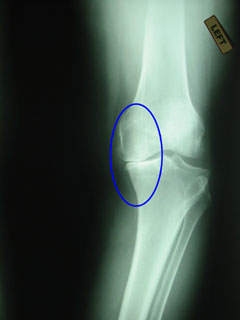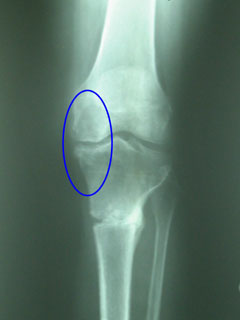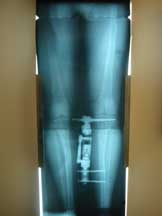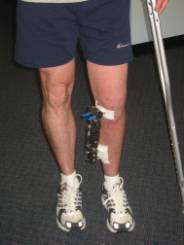High Tibial Osteotomy (HTO)
If one part of the joint is worn out, the angle of the leg bone can often be changed to shift stresses onto other areas that are not so worn. This procedure can produce years of pain relief, as an alternative to joint replacement, in appropriate patients.
Regenerated Cartilage After HTO and Microfracture
The following X-rays show the knee joint before and 3.5 months after HTO surgery. Notice that the left hand side of the joint originally showed bone touching bone. In the after surgery X-ray, space can be seen between the bones. This means that there is now cartilage present in this joint.


Definition of a varus knee:
The knee of a bowlegged person. Some people have this alignment naturally. Others develop it when a knee collapses from arthritis.
Definition of medial compartment arthritis:
Degeneration of the medial or inside compartment of the knee. Patients experience pain in this area. They also have swelling and reduced function.
Purpose of procedure:
There are two main reasons to perform high tibial osteotomy. For patients with medial compartment arthritis and a varus knee, its purpose is to provide years of relief prior to knee replacement. This is particularly important in patients too young to be optimal candidates for knee replacement. The other reason it is done is to correct malalignment in patients undergoing another procedure such as Carticel implantation. In these patients the HTO is performed to protect the cartilage replacement from failure due to excessive compressive forces on the graft.
Valgus knee and distal femoral osteotomy (DFO)
Some patients instead of being bowlegged (varus deformity), are knock-kneed or have a valgus knee deformity. To correct this problem, distal femoral osteotomy can be performed. This is similar to the HTO, but instead of cutting and adjusting the tibia, the femur, or bone in the upper leg is cut instead. This procedure is rarer than HTO, but the surgical process, post-operative course, risks and benefits, and outcome is similar.
Surgical notes:
The procedure is performed in a hospital with the patient going home either the same day or after a 23 hour or less observation in the hospital. The tibia or shinbone is cut and straightened. At Illinois Sportsmedicine we insert pins above and below the bone cut. Then a device called an external fixator is used to connect these pins. The patient turns a small crank at home to gently, painlessly and imperceptibly straighten the tibia. X-rays are taken in the office during the initial one to two weeks that the patient wears the fixator. These X-rays are used to ensure that the knee is precisely aligned to the desired configuration. Once satisfactory alignment is achieved, the fixator is locked and the bone is allowed to heal. During the healing period, patients can generally progress their activities as tolerated. At about 3 months, healing is generally complete enough to remove the fixator and the metal pins. This is done under a brief general anesthetic in the operating room.
 Success rate:
Success rate:
Most patients will have significant improvement. Over time the pain tends to return in some patients. Even so, 15 to 20 years after surgery, many patients will still have significant pain relief.
Risks and complications:
There is about a one percent incidence of deep infection. However, about half the patients will have superficial skin infections around the pins at some point. These are usually easily treated with oral antibiotics. Occasionally a patient will have stiffness requiring further surgery. Other rate complications that have been reported, but not seen in our practice include, but are not limited to, nerve injury and reflex sympathetic dystrophy.
Associated procedures:
Often a microfracture to regenerate new joint cartilage is performed at the same time as the HTO. Microfracture is performed arthroscopically.
Alternative methods of performing HTO:
 HTO also can be performed by cutting the bone all at once and inserting a plate. At Illinois Sportsmedicine we use the external fixator method instead for two reasons. First, the fixator permits the patient to reach an exact alignment that can be checked with X-rays. With the plate method, the bone is cut, a wedge of bone is removed, and the tibia is straightened all at once. It is difficult to achieve the desired alignment using this method with as high a degree of accuracy as the external fixator method. Second, the external fixator method does not compromise future total knee replacement if that procedure becomes necessary. The plate method is done near the knee joint and in some cases can make future total knee replacement difficult and the ultimate result less successful.
HTO also can be performed by cutting the bone all at once and inserting a plate. At Illinois Sportsmedicine we use the external fixator method instead for two reasons. First, the fixator permits the patient to reach an exact alignment that can be checked with X-rays. With the plate method, the bone is cut, a wedge of bone is removed, and the tibia is straightened all at once. It is difficult to achieve the desired alignment using this method with as high a degree of accuracy as the external fixator method. Second, the external fixator method does not compromise future total knee replacement if that procedure becomes necessary. The plate method is done near the knee joint and in some cases can make future total knee replacement difficult and the ultimate result less successful.
Options if the procedure fails:
If HTO fails then either a unicompartmental knee replacement or total knee replacement may be needed.